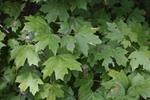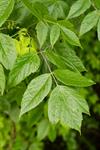| Family | Scientific Name | Common Name | Habitat | Distribution | Image |
|---|---|---|---|---|---|
| Sapindaceae | Acer buergerianum | Trident Maple | Used horticulturally, seeding down nearby and likely to spread more extensively in the future. | Native of China and Japan. | |
| Sapindaceae | Acer campestre | Hedge Maple | Suburban woodlands, planted and persistent and weakly spreading. | Native of Europe and w. Asia. Reported to be "occasionally spreading from cultivation to moist, rocky, disturbed woods" in sc. and se. PA (Rhoads & Klein 1993; Rhoads & Block 2007). |  |
| Sapindaceae | Acer floridanum | Southern Sugar Maple, Florida Maple, Sugartree | Bottomland forests, mesic slopes, especially common over mafic or calcareous rocks, but not at all limited to such situations; also widely planted in southern cities and towns as a street tree. | S. VA, w. KY, se. MO, e. OK, c. OK, and n. TX, south to c. peninsular FL and e. TX. |  |
| Sapindaceae | Acer ginnala | Amur Maple | Cultivated, rarely and sparingly escaped to roadsides, disturbed areas, and suburban woodlands. | Native of e. Asia. Reported as "cultivated and occasionally escaped" in s. PA (Rhoads & Klein 1993; Rhoads & Block 2007). Wright et al. (2023) report local naturalization from two separate sites in VA. |  |
| Sapindaceae | Acer grandidentatum | Canyon Maple, Bigtooth Maple | Limestone canyons. | C. TX, west to sw. MT, e. ID, w. WY, sw. CO, UT, NV, NM, AZ, w. TX, and Mexico (SON, CHH, COA, NLE, and TAM). |  |
| Sapindaceae | Acer japonicum | Full Moon Maple | Uncommonly cultivated; rarely persistent or seeding down. | Native of Japan. |  |
| Sapindaceae | Acer leucoderme | Chalk Maple | Rocky slopes and bluffs, particularly over mafic or calcareous rock, on the Gulf Coast in floodplains. | A species of se. North America, primarily of the Piedmont from NC to AL, less commonly in the Ridge and Valley of se. TN (Chester, Wofford, & Kral 1997), low Blue Ridge of w. NC and adjacent TN and GA, Coastal Plain of Panhandle FL, GA, AL, MS, LA, and se. TX, and in sw. AR and se. OK. |  |
| Sapindaceae | Acer negundo var. negundo | Eastern Box Elder, Ash-leaved Maple, River Maple, Arce, Fresno de Guajuco | Riverbanks, swamps, bottomlands, also upslope on calcareous substrates. | The species ranges nearly across North America, including well into the arid west along rivers. Var. negundo occurs from NB west to MB, south to c. peninsular FL and TX. |  |
| Sapindaceae | Acer negundo var. texanum | Great Plains Box Elder, Texas Box Elder | Floodplains. | Western and central North America south to sc. Mexico. | |
| Sapindaceae | Acer nigrum | Black Maple | Riverbanks, streambanks, cove forests, river slope forests, especially over calcareous rocks. | NH west to MN, south to NC, GA, AL, AR, and KS, primarily west of the Appalachians. |  |
| Sapindaceae | Acer palmatum | Japanese Maple | Suburban woodlands. | Native of e. Asia. Frequently planted in its numerous cultivars. Serviss & Serviss (2022) documented its naturalization in AR. It is also reported as escaped in the DC area (Shetler & Orli 2000). |  |
| Sapindaceae | Acer pensylvanicum | Striped Maple, Moosewood, Whistlewood | Dry to mesic forests. | NS west to MB, south to w. NC, nw. SC, ne. GA, e. TN, WI, and MN. |  |
| Sapindaceae | Acer pictum ssp. mono | A single specimen from e. TN purports to document this taxon in our area. It is apparently from a natural area, and shows leaf lobing features suggestive of this taxon, but seems more likely to represent an aberrant leaf form of A. saccharum. | |||
| Sapindaceae | Acer platanoides | Norway Maple | Suburban woodlands, disturbed forests, hedgerows. | Native of Europe. In much of the ne. United States, A. platanoides has become a noxious weed tree. |  |
| Sapindaceae | Acer pseudoplatanus | Sycamore Maple | Suburban woodlands. | Native of Europe. Planted widely in our area as a street and yard tree, especially in the mountains. Naturalizing from horticultural use in City of Alexandria (Simmons et al. 2020). Northward it is a noxious weed tree. |  |
| Sapindaceae | Acer rubrum var. drummondii | Drummond’s Maple, Swamp Red Maple, Drummond’s Red Maple | Swamps and floodplains, often in deeply flooded situations. | A. rubrum var. drummondii is probably limited to the Mississippi River basin and its immediate tributaries; reports from more eastern areas likely represent pubescent extremes of Acer rubrum var. trilobum. |  |
| Sapindaceae | Acer rubrum var. rubrum | Eastern Red Maple, Scarlet Maple | Upland deciduous forests, up to at least 1500m elevation, moist bottomlands and slopes. | This variety is the most widespread and common in our area; indeed it is one of the most ubiquitous and common trees of e. North America. |  |
| Sapindaceae | Acer rubrum var. trilobum | Carolina Red Maple, Swamp Maple, Water Maple | Wetlands, especially peaty, acid sites. | Primarily a Southeastern Coastal Plain variety, the range of var. trilobum is unclear, possibly extending well inland and northward. |  |
| Sapindaceae | Acer saccharinum | Silver Maple, Soft Maple, White Maple, River Maple | Bottomlands, riverbanks, and disturbed areas; also commonly planted as a street tree. | NS west to SK, south to Panhandle FL, LA, and OK, rare and mostly introduced east of the Appalachians and south of VA. This is an abundant tree along major rivers in the Piedmont of VA. In some parts of our area, the species is more common as a street tree or an escape from cultivation than as a native tree. On the Coastal Plain of NC and SC, A. saccharinum is largely confined to the banks and levees of large brownwater rivers, such as the Roanoke and Congaree. |  |
| Sapindaceae | Acer saccharum var. saccharum | Sugar Maple, Hard Maple, Sugar-tree | Cove forests, other rich forests, especially over mafic and calcareous rocks, on calcareous soils common and typical in dry-mesic forests and dry woodlands as well, less typically extending to high elevation northern hardwood forests where sometimes in acidic situations (as in Highlands County, VA), in parts of the Piedmont perhaps more common as an introduction by ornamental planting than as a native, at least south of VA. | Var. saccharum is distributed from NS west to ND, south to n. GA, n. AL, and MO. A. saccharum var. saccharum is the primary source of maple sugar and maple syrup; formerly, commercial sugaring was done in w. NC and w. VA. Large individuals of this species are the favorite substrate of a number of lichens, including Lobaria pulmonaria. The brown, platy bark is often similar to that of Aesculus flava. For its bright orange fall color, A. saccharum var. saccharum is one of our most prized ornamental trees. In NC, it is most common northward and on mafic rocks, thus reaching perhaps its best development in the amphibolite peaks of Ashe, Watauga, Avery, and Mitchell counties; it is more general in more northern and more calcareous portions of our region. |  |
| Sapindaceae | Acer saccharum var. schneckii | Schneck's Maple, Sugar Maple, Southern Hard Maple, Rock Maple | Dry, dry-mesic, and mesic forests over calcareous substrates. | Acer saccharum var. schneckii Rehder is poorly understood, and may be distributed from sw. PA, s. OH, s. IN, s. IL, MO, south to nw. GA, n. AL, n. MS, sw. AR, and e. OK. |  |
| Sapindaceae | Acer spicatum | Mountain Maple | High elevation forests (northern hardwoods or spruce-fir), generally above 1500 m in NC, above 900 m in VA, especially common in periglacial boulderfields. | NL (Newfoundland), NL (Labrador), and SK south to PA, OH, and IA, and in the mountains to w. NC, nw. SC (Bradley et al. [in prep.]), e. TN, ne. GA, and ne. AL. |  |
| Sapindaceae | Acer tataricum | Tartarian Maple | Disturbed areas. | Native of Eurasia. |  |
Cite as...